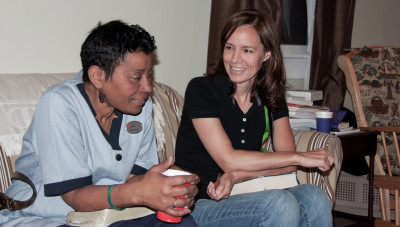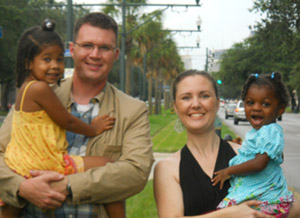Several years ago, my wife and I adopted two multi-racial daughters. Our family is one of Anglo, African-American, and Hispanic cultures. Because of the multi-racial background of our family, we felt led from the Lord to start a multi-racial church in one of the most multi-racial areas of New Orleans. In January 2011, the Lord birthed Mosaic Church of New Orleans, a multi-ethnic church in the heart of the city.
Even though we read about the gathering of all the nations to worship Christ in Revelation chapter 4, Sunday mornings are still some of the most segregated times in our society. The question is, Why? Skin color and racial background are large components of our individual identity. While it may be hard to discriminate against other people because of something like intelligence, it is quite easy to discriminate based on something as obvious as skin color.
Did the early Christians deal with racial and ethnic tension in the early church? The book of Acts is filled with such references. We normally read Acts to look at early church growth, the work of the Holy Spirit, and Paul’s missionary journeys. But Acts is also filled with racial and ethnic tension that may be more implicit than explicit. For example, chapter 6 addresses the language differences in the early church between Greeks and Jews. Chapter 8 shows Peter and John being dispatched to address the racial background of new converts. Chapters 9 through 11 tell the story of Peter coming to a multi-ethnic understanding of the Gospel. Chapters 13-15 show how a major part of the discussions at the council of Jerusalem were about cultural identity and evangelism.
At Mosaic Church we actually prefer the term “multi-cultural” because the diversity we seek goes beyond race. It also includes ethnicities, cultures, generations, and socio-economic groups. Churches must reflect the communities in which they exist. If your church is in a predominantly Anglo area, then you probably are not going to have many Asians. However, more often than not, churches are not truly representative of the neighborhoods surrounding them.
I believe that multi-cultural churches are necessary for the survival of churches for the next several decades, especially in urban areas. The growth of cities and immigration have necessitated churches embrace the changing racial mix around them. Why are cities so important? Statistics tell us that by 2050, for the first time in history, the urban population will be greater than the non-urban population; and that population will not be all Anglo, but rather will be majority non-white and a mix of races and nationalities. Many urban centers are already experiencing this mix.
Is it necessary to be intentionally multi-cultural? Yes, because left to ourselves, we will socialize and fellowship with those persons who are most like us. While there is nothing inherently wrong with that, often we fellowship with those similar to us to the neglect of those different than us. Believers must intentionally find ways to form relationships with those from various racial and cultural backgrounds of those who are reflected in their community.

For the past several decades, church planting has been dominated by the homogeneity principle, which states that churches grow the fastest when the people reach out to those like themselves. Persons can certainly reach other people with the Gospel quicker when they reach out to those like themselves.
Once again the issue is that the Great Commission commands us to reach those who are like us as well as different than ourselves. Since the 1960s, suburbs have been primarily homogenous, so the homogeneity principle has worked well. With the urban landscape changing, a new multi-cultural principle for church planting must replace the homogeneity principle.
In the same way, just because a church has a few people that are of the non-dominant ethnicity does not mean that a church is truly multi-cultural. Rather the multi-cultural vision for a church must come from the leadership actively pursuing the vision. Sometimes this means purposefully pursuing qualified individuals who are representative of the various ethnicities in a church’s local community who can serve in pastoral and leadership roles.
Pastors of a multi-ethnic church must be willing to “share the sacred” tasks of the church, such as preaching, worship, and communion. By “sharing the sacred,” pastors show that they truly allow the most important tasks of the church to be shared with those of a different ethnicity. Many times churches will merely hire someone of a different ethnicity, hoping that such a move will attract those of another race to their church, but by sharing the very public tasks of ministry and worship, the church leadership displays a commitment to a multi-cultural vision.
What practical steps can a church take to become more multi-cultural? First, a church must grasp a multi-cultural vision for their community. Often a church merely needs to observe the people surrounding them and ask, “Do we look like our community?” Churches should not only look at race and ethnicity, but also age and socio-economic groups.
Second, a church should be willing to “do life” together. By “do life,” a church should not be satisfied with merely worshipping together but instead should be willing to enter into relationships that run deep and continue to exist beyond the Sunday worship hour.
 Third, churches will need to develop a strategy that fits their context. I recommend several books by Pastor Mark Demayz, who pastors a multi-cultural church in Arkansas. Demayz is a forerunner in writing about multi-cultural churches and shares biblical and practical wisdom in his books.
Third, churches will need to develop a strategy that fits their context. I recommend several books by Pastor Mark Demayz, who pastors a multi-cultural church in Arkansas. Demayz is a forerunner in writing about multi-cultural churches and shares biblical and practical wisdom in his books.
Last, a word of caution must be given. A church’s vision should not see multi-culturalism as the end in and of itself. Making disciples for Christ should be every church’s primary vision. At the same time, churches must be very intentional about pursing a multi-cultural vision as a part of the overall discipleship process. Why? Because we are given the commission to make disciples of all nations, ethnicities, and socio-economic group. If diversity is pursued as the only mission, it becomes a classic case the tail wagging the dog.



Comment(1)
Carson says
July 9, 2014 at 9:58 pmI see a lot of interesting articles on your blog. You have to spend a lot of
time writing, i know how to save you a lot
of work, there is a tool that creates unique, SEO friendly articles in couple of minutes, just type
in google – k2 unlimited content